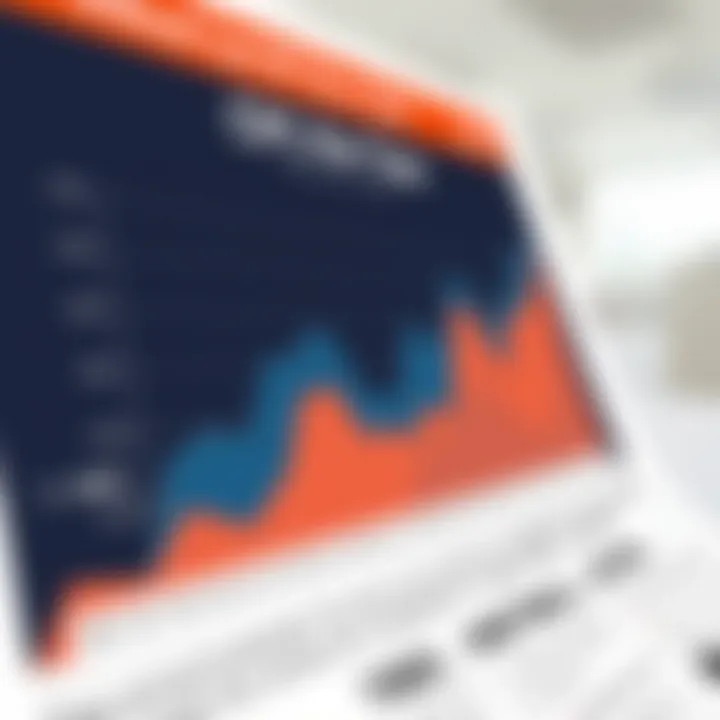Understanding Facebook Cost Per Click: An In-Depth Guide


Intro
In today's digital marketplace, Facebook stands out as a titan in the realm of advertising. With billions of users scrolling through their feeds daily, understanding its Cost Per Click (CPC) model is crucial, whether you're just dipping your toes in the marketing waters or you're an old hand with experience under your belt. The intricacies of CPC can seem daunting at first, but they hold the key to crafting effective advertising strategies that can make or break your campaign.
Investment Dictionaries
Navigating the complex world of Facebook advertising requires a grasp of certain terminologies and strategies that shape your investment decisions. Knowing what these terms mean can help demystify the process and allow for more informed decisions.
Key Financial Terms
Here are some essential terms to familiarize yourself with:
- Cost Per Click (CPC): This is the amount an advertiser pays each time a user clicks on their ad. It’s a crucial metric for evaluating the effectiveness of ad campaigns.
- Click-Through Rate (CTR): This percentage measures how many people clicked on an ad after seeing it. A higher CTR suggests that the ad resonates with the audience.
- Ad Spend: This refers to the total money an advertiser allocates to a campaign over a set period. Proper management of ad spend is necessary to ensure optimal results without overspending.
- Quality Score: This is a metric Facebook uses to determine the relevance of ads. A higher quality score typically leads to lower CPC.
By understanding these terms, one can better navigate the nuances of campaign performance and outcomes.
Investment Strategies Explained
When diving into Facebook advertising, keeping your strategy tight is imperative. Consider the following strategies:
- Targeted Audience Demographics: Tailoring your ads to specific demographics can improve ROI. Understanding who your audience is will help craft ads that speak directly to them.
- A/B Testing: This method involves running two versions of an ad to see which performs better. Testing different elements can reveal what resonates more with your audience, thereby optimizing CPC.
- Budget Allocation: Effective budget management is crucial. Allocate budgets based on performance metrics to maximize impact while minimizing waste.
Financial Product Comparisons
To measure the effectiveness of your Facebook campaigns, comparing performance metrics and conducting thorough cost-benefit evaluations is key.
Performance Metrics Analysis
Monitoring performance metrics allows you to assess the health of your advertising campaigns accurately. Important metrics to track include:
- Return on Ad Spend (ROAS): This indicates how much revenue you’re generating for each dollar spent on advertising. Understanding ROAS can help refine your ad strategy.
- Conversion Rate: This measures the percentage of users who take a desired action after clicking an ad; higher rates indicate effective advertising.
- Engagement Rate: This metric shows how users interact with your ads, including likes, comments, or shares. A high engagement rate often correlates with stronger brand affinity.
Cost-Benefit Evaluations
When considering how much to invest in Facebook advertising, conducting a cost-benefit evaluation can provide valuable insights. Here’s how:
- Assess Costs: Review all costs associated with your campaign including ad spend, production costs, and time.
- Evaluate Benefits: Measure the benefits realized from your campaign, such as revenue generated or brand awareness achieved.
- Analyze Net Gain: Subtract your total costs from total benefits to determine net gain or loss.
This structured approach ensures that you make data-driven decisions and supports budgeting for future campaigns.
"With clear insight into CPC and performance metrics, advertising on Facebook can transform from a daunting task into a powerful tool for business growth."
By synthesizing these elements and strategies, you pave the way for achieving better outcomes in your Facebook advertising efforts. For further reading and resources on Facebook advertising best practices, you may find Facebook's Business Site helpful. Additionally, Wikipedia provides a foundational understanding of Cost Per Click. Understanding these concepts is not just for novice marketers but essential for seasoned professionals looking to refine their skills.
Foreword to Facebook Advertising
In today's digital landscape, where countless advertisements compete for consumer attention, Facebook has emerged as a significant player in online marketing. Its robust platform provides advertisers with an opportunity to reach billions of potential customers and tailor their marketing efforts with precision. This section serves as an introduction to the intricate world of Facebook advertising, laying a foundation for understanding the key dynamics behind its cost structure, particularly the cost per click (CPC) model.
With its deep understanding of user behavior, Facebook offers advertisers valuable insights that can make a remarkable difference in campaign outcomes. If a marketer truly comprehends these fundamental aspects, they can harness Facebook to maximize their return on investment. This is particularly relevant in today's economy, where every cent spent on advertising should count, making awareness of Facebook's tools and features more important than ever.
The Evolution of Digital Advertising
Digital advertising has transformed dramatically since the early days of the internet, evolving from simple banners on static websites to intricate campaigns that leverage data and technology. Initially, advertiser's options were limited, relying mostly on text ads and basic display advertisements. As user behavior began to be tracked more effectively, marketers discovered more sophisticated methodologies to engage audiences.
- Early Days: Initially dominated by keywords and basic demographic information, ads were often bombarding users without much personalization. The effectiveness of these advertisements was often limited.
- Rise of Social Media: The launch of social media platforms brought a revolution in the way advertisements could approach audiences. Marketers could adjust their strategies based on engagement metrics, likes, and shares.
- Data-Driven Approaches: Now, with advanced analytics, advertisers can tailor ads to specific audiences based on interests, behaviors, and even life events.
The advent of social media advertising, particularly through networks like Facebook, has redefined how marketers interact with audiences, emphasizing the importance of relevancy in ad delivery.
Significance of Facebook in Online Marketing
Facebook holds a unique position in the online marketing ecosystem. Hosting billions of active users, it enables advertisers to precisely target audiences with tailored messages. This is not just about reaching out but about having a genuine impact. Here are several reasons why Facebook should be at the forefront of any marketing strategy:
- Extensive Reach: Advertising on Facebook means gaining access to a vast and diverse audience, allowing for mass visibility.
- Granular Targeting Options: Advertisers can target potential customers based on various criteria: age, gender, geographic location, interests, and more.
- Cost-Effectiveness: Facebook advertising is often more affordable than traditional methods, providing excellent metrics for evaluating performance.
- Engagement: Facebook's native engagement tools, such as comments, shares, and likes, enable advertisers to create dynamic interactions with potential customers.
To sum it up, the significance of Facebook in online marketing cannot be overstated. It is not merely a social platform; it is an ecosystem for businesses to engage, learn, and optimize their marketing efforts.
Understanding these foundational elements of Facebook advertising will pave the way for discussing more complex topics like cost per click, audience targeting, and the auction dynamics that govern this advertising space.
Defining Cost Per Click
Understanding Cost Per Click (CPC) is pivotal for anyone wanting to navigate the waters of Facebook advertising successfully. CPC represents the amount an advertiser pays each time a user clicks on their ad. This payment method is essential as it ties directly into the performance of advertising campaigns, allowing businesses to measure effectiveness in terms of driving traffic or conversions. By defining CPC properly, advertisers are better positioned to evaluate their budgeting and overall marketing strategy. Having a firm grip on this concept leads to more informed decisions and optimized ad spend.


What is Cost Per Click?
Cost Per Click is more than just a metric; it's a fundamental aspect of online advertising that shapes how ads are purchased on platforms like Facebook. In simple terms, it is the amount an advertiser pays when someone clicks on their ad. This model can be contrasted with other pricing methods, such as CPM (Cost Per Mille), where payment is based on impressions rather than clicks. CPC focuses on actual engagement, meaning that advertisers are charged only when users exhibit interest by clicking on their ad, which can lead to higher conversion rates if executed well. In light of campaign goals, understanding this payment structure is crucial as it aligns budget allocation with tangible interactions.
How CPC is Calculated
Calculating CPC involves understanding both the total costs incurred by an ad campaign and the number of clicks it generates. The formula is straightforward:
CPC = Total Cost of Ad Campaign / Total Clicks
For instance, if an advertiser spends $100 on a Facebook campaign and receives 200 clicks, the CPC would be $0.50.
Several factors can influence this calculation, including:
- Quality of the ad: Higher quality ads tend to result in more clicks, potentially lowering the CPC.
- Bid Strategy: Advertisers can set their bid based on their campaign objectives, which affects CPC.
- Target Audience: The more relevant the audience, the better the chances of clicks, which can bring down the overall CPC.
Understanding these factors isn't just useful; it's essential for any marketer looking to maximize the return on their ad spend.
CPC vs. Other Pricing Models
Understanding the distinction between CPC and other pricing models like CPM and CPA (Cost Per Acquisition) is vital for navigating Facebook’s advertising landscape.
CPC vs. CPM: While CPC charges based on user clicks, CPM includes charges for ad impressions, regardless of engagement. Advertisers aiming to enhance visibility might lean towards CPM to garner brand exposure, while those focused on direct responses may prefer CPC, as it's strictly performance-based.
CPC vs. CPA: CPA is a more focused model that charges advertisers only when a user takes a specific action, like making a purchase. While CPC is advantageous for generating clicks, CPA often yields better insights into conversion success, making it suitable for campaigns where final goals are more nuanced.
Each model serves a purpose, and understanding their differences allows advertisers to tailor their strategies according to what they want to achieve.
In summary, defining Cost Per Click is not merely about numbers; it's about the strategy behind them. Knowing how CPC functions facilitates a more granular approach to Facebook advertising, ultimately allowing businesses to spend their marketing dollars more wisely.
Understanding Facebook's Advertising Auction
The advertising auction on Facebook is not just a peripheral aspect of how ads get displayed; it’s the very engine driving the platform's ad mechanism. Understanding this auction is crucial, especially for advertisers keen on minimizing their costs and maximizing their reach. This section will unpack the essential elements of the auction process, illuminate the role advertisers play, and explore what it takes to emerge victorious in this competitive landscape.
Mechanics of the Auction Process
When you put an ad on Facebook, what happens behind the scenes can resemble a bustling marketplace. Advertisers submit their bids on ad placements based on several factors, including their target audiences, campaign goals, and budget constraints. The auction is not merely about who has the highest bid; Facebook employs a method known as the Ad Auction, which evaluates all bids against three main criteria:
- Bid Amount: The total maximum amount an advertiser is willing to pay for a click or impression. A higher bid can often mean better visibility but can vary based on other factors.
- Ad Quality: Facebook assesses the creative aspect of the ad. Ads that resonate well with the audience and have a high relevance score may win out over higher bids.
- Estimated Action Rates: This involves predicting how likely it is that the user will take the desired action, like clicking the ad or making a purchase.
When all is said and done, the ad that combines the best balance of bid, quality, and estimated action rates wins the spot. Thus, the mechanics of the Facebook advertising auction are more intricate than simply who’s willing to pay more.
Role of Advertisers in the Auction
Advertisers are central players in this structured system. Understanding how to navigate the auction dynamics can lead to significant advantages. Each advertiser must strategically set their budget and bid type—whether cost-per-click or cost-per-impression—based on their campaign goals.
Additionally, advertisers must focus not only on their bids but also on creating compelling ads that effectively engage their target audience. The ad copy and visuals need to resonate with Facebook users while aligning with the expected quality standards set by the platform.
One of the vital aspects is audience targeting. An advertiser's ability to hone in on their desired demographic dramatically impacts performance within the auction paradigm. For instance, ads aimed at a broad audience may find themselves drowned out by competitors targeting the same users with more relevant ads.
Winning the Bid: Factors to Consider
Success in Facebook's ad auction doesn't boil down to just having deep pockets. Several influential factors can make or break an ad campaign. Here’s what to watch for:
- Ad Relevance: The better the ad is suited to its target audience, the higher its relevance score. Creating ads that speak directly to viewers can dramatically improve their effectiveness.
- Historical Performance: An account with a clean record of strong ad performance may receive favorable treatment during the auction. Facebook’s algorithms favor ads that historically drive clicks, engagement, and conversions.
- Timing and Placement: When and where your ad appears is crucial. Ads displayed during peak user engagement times or in highly viewed spaces may yield better results than those shown during off-peak hours.
The true essence of the auction is finding the sweet spot between cost, reach, and engagement.
Ultimately, understanding the underlying mechanics, recognizing the roles played by advertisers, and considering the right factors will lead not only to a better understanding of Facebook’s advertising auction but also to more successful ad campaigns. By adapting strategies based on auction dynamics, advertisers can significantly improve their bidding outcomes.
Influencing Factors of Facebook CPC
Understanding what drives Facebook’s cost per click (CPC) is essential for marketers aiming to maximize their advertising returns. The intricate interplay of several factors determines how effectively an ad can reach its desired audience and ultimately convert interest into action. Knowing these elements allows advertisers to tailor their strategies for better performance while keeping an eye on costs. Advertising on Facebook is not just about spending money; it's about wise investment, making each cent count.
Target Audience Characteristics
First off, let’s delve into target audience characteristics, which are pivotal in determining your ad's effectiveness and cost. Understanding who you’re trying to reach is like having a map before setting out on an adventure. For instance, age, gender, location, and even interests play a significant role in how likely users are to engage with your ad. When you pinpoint your audience accurately, your CPC decreases because Facebook optimizes the delivery of your ads to those who are genuinely interested.
- Demographics: Younger audiences might respond better to trendy products, while older consumers may prefer practicality and reliability.
- Interests: Knowing that an individual has an interest in fitness can be the differentiator between a successful ad and a flop. Tailor your content to resonate with these specific inclinations.
- Behavioral Patterns: Observing how users interact with similar ads can also inform your strategy. If they tend to click on videos more than images, that's valuable insight for your own campaigns.
By aligning your ad targeting with these characteristics, not only do you improve your chances for engagement, but you can also achieve a lower CPC.
Ad Quality and Relevance Score
Next, let's talk about ad quality and relevance score. Anyone who's ever wandered into a shop only to find messy shelves knows how a poor presentation can push people away. Facebook’s algorithm rewards high-quality ads with lower costs. The relevance score, which ranges from 1 to 10, examines how well your ad resonates with your target audience. It takes into account factors like ad engagement rates and feedback from users, such as the number of people who hide your ad.
When creating ads, keep these tips in mind:


- Clear Messaging: Ensure that your ad conveys its message instantaneously. Users should know what you’re offering without having to scour through lengthy text.
- Visual Appeal: High-quality images or videos grab attention. Think of this as your storefront—if it’s appealing, customers will want to step inside.
- Call to Action (CTA): A clear CTA makes a world of difference. Guide users on what the next steps are, be it visiting a website or signing up for a newsletter.
Regularly analyzing your relevance score enables you to adjust your ad strategies in response to audience feedback. A noticeable improvement in your score often results in reduced CPC.
Industry Competition and Trends
Finally, industry competition and trends can greatly influence your CPC. The more advertisers vying for a particular audience, the higher the costs can soar. Think of a busy marketplace: as more vendors set up shop, you might have to lower prices to draw in customers. Staying updated about industry trends can provide strategic advantages.
- Market Research: Keep an eye on competitors. What are they doing well? What could they improve? Such insights can help tailor your ad approach to fill gaps in the market.
- Ad Saturation: Recognize when an audience has been bombarded with ads. Timing is crucial; sometimes, pulling back or varying your ad type can renew interest.
- Seasonal Trends: Holidays or events often bring shifts in user behavior. Capitalizing on these times requires flexibility and quick adjustments to ad strategies.
In the fast-paced world of digital advertising, staying one step ahead of the competition is vital. Being aware of market dynamics allows for more informed decision-making.
Strategies to Optimize CPC on Facebook
Navigating the world of Facebook advertising can feel like traversing a maze, particularly when it comes to Cost Per Click (CPC). This section explores the strategies that can significantly reduce expenditures while maximizing the effectiveness of ad campaigns. Taking a proactive approach to optimizing CPC is essential for businesses aiming for a higher return on investment.
Importance of Audience Targeting
Audience targeting acts as the preferential compass in the chaotic landscape of Facebook ads. By pinning down the right demographic segments, businesses can direct their resources effectively, ensuring that every click leads meaningful engagement.
Consider these points:
- Precision: Crafting campaigns that speak directly to specific audiences can significantly enhance click-through rates (CTR). For instance, a local bakery could target a zip code area around its store to ensure relevance.
- Segmentation: Utilizing Facebook's in-built analytics makes it easier to distinguish between various audience segments. Separate campaigns can be created for young adults interested in culinary artistry, while others can be crafted for older communities drawn to traditional recipes.
- Further Insights: Facebook's Advanced Audience Insights allows advertisers to understand broader patterns and behaviors in their interest groups.
Engaging directly with the target audience increases the likelihood of actions taken after clicking. In short, focused audience targeting is like putting the right bait in the water to lure in specific fish—only the right catch is worth the effort.
Ad Creative and Messaging Tips
When it comes to Facebook ads, the ad creative serves as the storefront window. If the display is lackluster, potential clicks will wane. A well-thought-out ad design and compelling messaging can make all the difference.
Consider the following approaches:
- Visual Appeal: High-quality images and aesthetically pleasing designs should be front and center. For example, if you’re promoting a smartphone, using vibrant, crisp images can catch the eye of potential customers amidst the countless scrolling feeds.
- Clear Messaging: The message should be straightforward and instantly understandable. A convoluted message can lead to confusion and loss of interest. It’s essential to present what the ad offers clearly and concisely in the first few seconds.
- Strong Call-to-Action (CTA): A clear and enticing CTA invites users to engage further. Phrases like "Shop Now" or "Learn More" help guide the viewer’s next steps.
Ultimately, the ad's creative and messaging work in tandem to capture user interest. Think of them as the good cop and bad cop—each plays a vital role in converting apprehensive viewers into engaged clickers.
Testing and Iteration for Better Results
Copywriting theories and design principles only hold water if they are tested and iterated upon. Continuous experimentation should be a core tenant of your CPC optimization strategy.
Here’s how to implement effective testing:
- A/B Testing: Comparing different versions of the same ad can yield invaluable insights. Simple adjustments, such as changing the image or call to action, can make differences in performance.
- Data Analysis: Diving into metrics such as CTR, engagement rates, and conversion statistics exposes what’s working and what's not. A thorough review is akin to a treasure hunt where the buried treasure is your ad’s potential engagement in each unique iteration.
- Adapt and Evolve: The iterative process allows advertisers to adapt strategies based on real-time feedback. If one copy performs better than another, don’t hesitate to pivot just like a canoe adjusting its path in rapids.
"What gets measured gets improved." - Peter Drucker
By focusing on these strategies, businesses will find themselves not only reducing costs but also increasing engagement and overall success.
Analyzing Results: Metrics Beyond CPC
The Importance of Metrics in Facebook Advertising
When diving into Facebook advertising, focusing solely on Cost Per Click (CPC) can be a slippery slope. While CPC is a vital metric, it barely scratches the surface of what marketers should truly be assessing. This section aims to shine a spotlight on other influential metrics that can provide a richer narrative about the effectiveness of your advertising campaigns. Understanding these additional metrics ensures a deeper comprehension of how well your ads are resonating with your target audience and ultimately driving business growth.
Conversion Rate and ROI Considerations
The conversion rate reveals the percentage of users who complete a desired action after clicking on an ad. This action could be anything from making a purchase to signing up for a newsletter. Knowing your conversion rate is crucial; it tells you how effective your ads are at generating not just clicks but meaningful engagement.
- Why It Matters: A high CPC could be misleading. If conversions are low, it indicates that clicks are insufficient in driving actual value. Therefore, balancing CPC with conversion rates provides a clearer picture of efficacy.
- Calculating ROI: To truly gauge effectiveness, consider the return-on-investment (ROI). Simply put, you take the profit generated from the campaign and subtract the costs involved in running it, including your CPC, then divide that figure by the total costs. This shows whether your efforts were financially worthwhile.
Engagement Metrics to Watch
Engagement is one of the soulmates to CPC—while CPC tells you the cost of clicks, engagement metrics shed light on user interactions following those clicks. Engagement metrics can include likes, shares, comments, and time spent on a landing page.
- Broader Insights: High engagement rates can indicate a strong connection with your audience, signifying content that resonates with their preferences.
- Identifying Trends: Monitoring these metrics over time can also help identify shifts in audience sentiment or interests, helping adjust strategies accordingly. Tools like Facebook Insights give granular views on how users are interacting with your content.
“Engagement is the heartbeat of social advertising; without it, the pulse weakens.”
Long-term Impact of Facebook Advertising
Looking at long-term effects is often overlooked amid the hustle for immediate results. The cumulative impact of Facebook advertising can be observed through brand awareness and customer loyalty. Professionals should consistently evaluate how campaigns contribute not just in the short run but in establishing a wider recognition and trust in your brand.


- Brand Recognition: Repeated ads can keep a brand in the consumer’s mind, creating familiarity that eventually leads to purchases.
- Customer Loyalty: Engaging customers effectively could touch off a cycle of loyalty. Satisfied customers are more likely to return, promote your brand via word-of-mouth, and engage in repeat purchases.
Case Studies: Success Stories on Facebook
In the realm of Facebook advertising, tangible success stories illuminate the effectiveness of strategies employed by various businesses. These real-world instances not only provide insight but also serve as a source of motivation for advertisers striving to achieve their marketing goals. Studying these examples highlights the dynamic aspects of Facebook's platform, showcasing diverse approaches that yield positive outcomes.
Small Business Triumphs
Small businesses often operate on limited budgets, making the optimization of every advertising dollar crucial. One notable example is a local bakery named "Sweet Treats," which faced stiff competition from larger chains. By leveraging Facebook's cost per click model, they honed in on their target demographic, which consisted primarily of young families.
Sweet Treats used eye-catching visuals and tailored promotional content to appeal to this audience. Their targeted ads featured delightful images of pastries and family gatherings that elicited warm memories and engagement.
Their strategy paid off; after just a few months, they reported a 150% increase in foot traffic on weekends. Furthermore, the bakery improved its social media presence, gaining an influx of followers who were eager to share their experiences with others. This translated into word-of-mouth advertising, further enhancing their visibility without incurring significantly more costs.
Key Takeaways for Small Businesses:
- Target Audience Focus: Know your audience deeply and create ad content that resonates with them.
- Visual Appeal: High-quality images can significantly improve engagement rates.
- Promotion Tracking: Regularly analyze which promotions yield the best results, refining the approach as needed.
Corporate Campaigns and Learning
On a larger scale, consider the case of "Tech Innovations," a multinational technology firm that wanted to introduce a new gadget. The challenge was not only about reaching potential customers, but also about portraying its brand image as a leader in innovation. Their approach involved a robust multichannel campaign that integrated Facebook ads with other digital marketing efforts.
Tech Innovations allocated a considerable budget towards their Facebook ads, emphasizing video content that showcased the product’s unique features. They carefully monitored the performance of their ads, analyzing variations in CPC across different audience segments.
Through A/B testing, they discovered that ads featuring short, snappy demonstrations attracted more clicks than lengthy testimonials. Subsequently, they shifted their focus towards these high-performing formats.
The campaign yielded impressive returns, with conversion rates exceeding expectations. They learned that even subtle changes in messaging and visuals can significantly impact engagement and CPC. The key aspect of their success lay in their willingness to adapt and learn from analytics, refining their strategy continuously for optimal performance.
Considerations for Corporate Campaigns:
- Adaptability is Key: Be ready to shift strategies based on data insights.
- Multi-Channel Integration: Combining efforts across platforms can amplify overall effectiveness.
- Measuring Success: Develop clear metrics to evaluate the impact of advertising campaigns on overall business goals.
In summary, success stories from both small businesses and corporations on Facebook exemplify the importance of strategic targeting, adaptability, and the savvy use of visual content in enhancing the effectiveness of advertising campaigns.
By learning from these examples, advertisers can refine their own approaches to harness the full power of Facebook's advertising capabilities, paving the way for their success.
Future Trends of Facebook Advertising
Understanding future trends in Facebook advertising is crucial for anyone who aims to stay ahead of the curve. The landscape of digital advertising is ever-changing, and being aware of emerging patterns can help marketers adjust their strategies accordingly. An adaptive approach can lead to better results and a more effective use of budgets. In an environment where user preferences and technology evolve rapidly, keeping an eye on what’s next is not just suggested, it's essential.
Predicting CPC Changes
As digital advertising costs fluctuate, predicting changes in Cost Per Click (CPC) remains a vital part of any marketing strategy. Various factors influence these shifts. For instance, seasonality typically plays a role. During the holiday season, businesses ramp up their ad spending, which could drive up CPC in competitive sectors like retail.
Additionally, shifts in Facebook's ad policies also influence CPC dynamics. If the platform decides to prioritize particular ad formats, or if new regulations are implemented, expect the landscape to change. This predictability not only assists in budgeting but also helps direct strategy. Here are a few considerations to keep in mind:
- Market Trends: With technology and user sentiment shifting rapidly, one must monitor not just Facebook’s own statistics, but broader market trends.
- Target Audience Behavior: Knowing when your audience is most active can help optimize the timing of your ads, potentially lowering costs.
- Competitor Analysis: Keeping tabs on how competitors are allocating their budgets and their ad strategies can offer unpredictable insights on CPC.
"Understanding the nuances behind CPC can mean the difference between wasted budget and maximized returns."
Emerging Technologies and Their Impact
Technology will undeniably shape the future of Facebook advertising. The integration of artificial intelligence (AI) and machine learning is already impacting how ads are targeted and delivered. These technologies can analyze vast amounts of data to identify patterns and help predict which ads perform best with which segments of the audience.
Furthermore, new formats like augmented reality (AR) ads could transform user engagement. Ads that allow users to virtually ‘try before they buy’ could see higher interaction rates and lower CPC as they pique curiosity. Here are some technologies to keep an eye on:
- AI-Driven Analytics: Platforms that harness AI can provide deeper insights into user behavior, leading to more tailored ad experiences.
- Interactive Ad Formats: As users become accustomed to engaging with ads in new ways, ad creatives that allow for interaction may stand out, potentially improving their effectiveness and reducing costs.
- Blockchain: While still in its infancy in advertising, blockchain technology could improve transparency in digital advertising, impacting CPC by enhancing trust with advertisers.
The takeaway? Navigating these emerging technologies is key to harnessing their full potential in improving ad effectiveness and managing costs on Facebook, thus leading to a more profitable advertising endeavor.
Ending: Navigating Facebook's Advertising Landscape
The realm of Facebook advertising is one that’s constantly changing, much like the tide at sea. Navigating this landscape can prove daunting, but understanding the underlying mechanics, especially the cost per click model, can position advertisers to leverage this platform effectively. The concluding section does not just serve as a summation of the knowledge gleaned throughout the article; rather, it opens a dialogue about the future of advertising in a world that is increasingly digital and data-driven.
When an advertiser steps into this marketplace, they are not just looking to place ads and leave it at that; there is a crucial need to continually assess strategies, audience engagement, and advertising performance. Just as one would adjust their sails according to the wind, advertisers must pivot and adapt their approaches based on data-driven insights. It is not enough to know about CPC and bidding strategies; one must also grasp how these elements fit together within the larger context of their marketing goals and customer needs.
Key Takeaways for Advertisers
Before diving deeper into the significance of ad adaptability, let’s highlight some key takeaways:
- Understand Your Audience: Tailoring ads to fit the right demographic is paramount. Thorough research into audience behaviors and preferences can lead to higher relevance and better results.
- Focus on Ad Quality: High-quality visuals and compelling messaging usually lead to a better click-through rate, thus affecting CPC positively.
- Data Monitoring is Key: Stay informed with analytics. Regularly check your ad performance metrics and adjust settings where necessary.
- Embrace Testing: A/B testing different versions of your ads allows you to understand what resonates best with your target audience. Don't put all your eggs in one basket.
These points highlight that while one may operate within the framework of CPC, the value of adaptability cannot be overstated.
The Importance of Ad Adaptability
In an environment as dynamic as Facebook’s, adaptability in advertising strategies can be the difference between success and failure. The landscape is not only influenced by changing user behaviors but also by new trends, technologies, and what’s trending in quieter corners of the internet. This makes it essential for advertisers to keep their fingers on the pulse.
- Responsive Campaigns: Just as the seasons change, so do the preferences of users. Campaigns should not be cast in stone. Regular updates and pivots based on real-time data can enhance relevance.
- Emphasizing Feedback Loops: Utilizing feedback from ad performance not only clarifies what works but also helps in identifying areas for improvement. Listening to the audience is as vital as any other aspect of advertising.
- Innovation in Approach: As algorithms evolve, so should strategies. Experimenting with new ad formats, like Stories or Reels, might yield surprising results.
Ultimately, advertising on Facebook demands agility. Advertisers willing to adjust their sails in tune with the currents are more likely to navigate successfully through the competitive waters of this robust digital platform.







